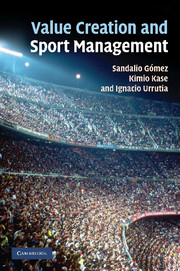Book contents
- Frontmatter
- Dedication
- Contents
- List of figures
- List of tables
- List of contributing authors
- Foreword
- Introduction
- 1 The virtuous circle of value creation in the sports industry
- 2 Value creation and performance criteria for sport entities
- 3 National context and profit strategy of the sport entity
- 4 Value creation in two of the most prestigious Spanish football clubs
- 5 The proto-image of Real Madrid
- 6 Value creation from the organizational structure of a sports entity
- Appendix I Why NGOs matter for the success of sporting events
- Appendix II Strategic evaluation of sponsorship and patronage
- Appendix III Structural characteristics of sport organizations
- Index
- References
5 - The proto-image of Real Madrid
implications for marketing and management
Published online by Cambridge University Press: 05 February 2014
- Frontmatter
- Dedication
- Contents
- List of figures
- List of tables
- List of contributing authors
- Foreword
- Introduction
- 1 The virtuous circle of value creation in the sports industry
- 2 Value creation and performance criteria for sport entities
- 3 National context and profit strategy of the sport entity
- 4 Value creation in two of the most prestigious Spanish football clubs
- 5 The proto-image of Real Madrid
- 6 Value creation from the organizational structure of a sports entity
- Appendix I Why NGOs matter for the success of sporting events
- Appendix II Strategic evaluation of sponsorship and patronage
- Appendix III Structural characteristics of sport organizations
- Index
- References
Summary
Introduction
The value creation model of Real Madrid is analysed and found to follow the culture-bound and vision-based strategic management style, albeit anchored to careful consideration of the cash-flow generation. It is also discussed that Real Madrid under the presidency of Florentino Pérez tried to move away from the dependency on sport events much in the same vein as Disney moving away to more stable revenue generation in the form of theme parks.
The relevance of sport in the economic field has experienced an extraordinary growth in recent years. Not only has it won a significant place in economic publications, but also in economic departments and programmes at universities (Szymanski, 2003), reflecting an increased popularity among economists and in the economic field.
Sports in general have become increasingly relevant in social life, as can be perceived just by looking at everyday news. There is a vast diversity of sport-related television programmes and even television channels showing only sport topics. Recent data show that, of the television news usually watched by 70 per cent of the Spanish population, approximately 20 per cent of airtime is given to topics related to sport, the same amount of time as politics. This social exposure of sport-related topics also contributes to the rise in fame of those who are involved in the world of sports, giving sport stars the same or even greater prestige than many politicians.
- Type
- Chapter
- Information
- Value Creation and Sport Management , pp. 145 - 175Publisher: Cambridge University PressPrint publication year: 2010



